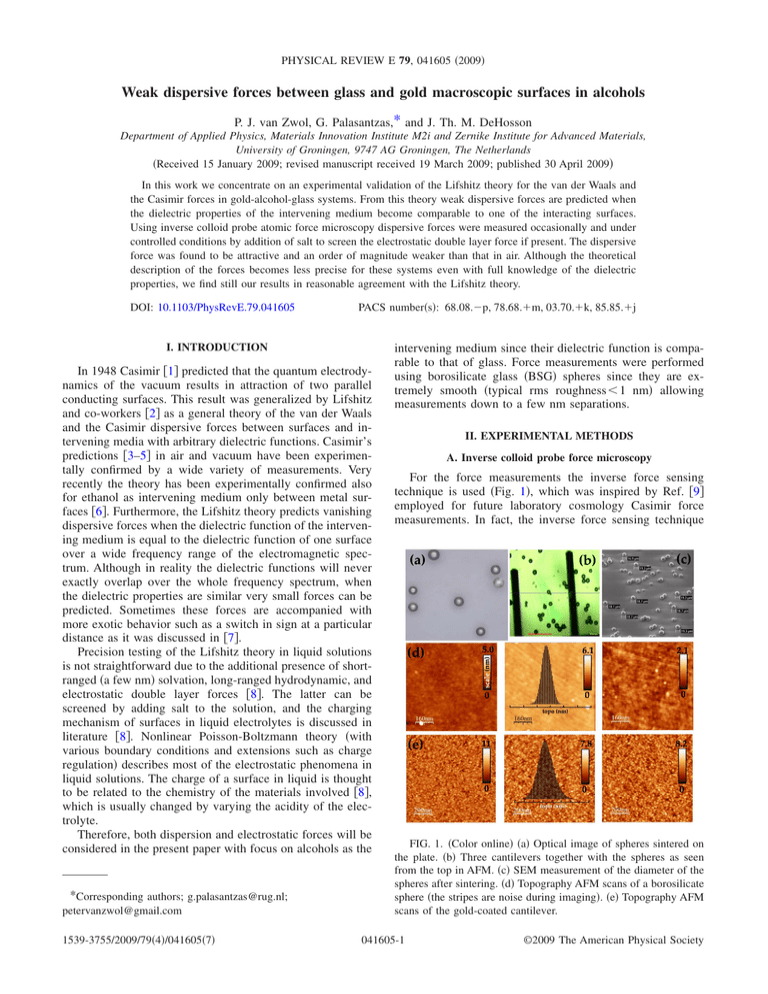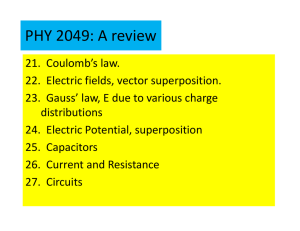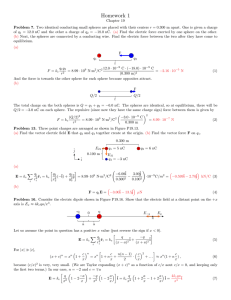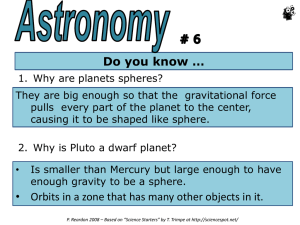paper-2
advertisement

PHYSICAL REVIEW E 79, 041605 共2009兲 Weak dispersive forces between glass and gold macroscopic surfaces in alcohols P. J. van Zwol, G. Palasantzas,* and J. Th. M. DeHosson Department of Applied Physics, Materials Innovation Institute M2i and Zernike Institute for Advanced Materials, University of Groningen, 9747 AG Groningen, The Netherlands 共Received 15 January 2009; revised manuscript received 19 March 2009; published 30 April 2009兲 In this work we concentrate on an experimental validation of the Lifshitz theory for the van der Waals and the Casimir forces in gold-alcohol-glass systems. From this theory weak dispersive forces are predicted when the dielectric properties of the intervening medium become comparable to one of the interacting surfaces. Using inverse colloid probe atomic force microscopy dispersive forces were measured occasionally and under controlled conditions by addition of salt to screen the electrostatic double layer force if present. The dispersive force was found to be attractive and an order of magnitude weaker than that in air. Although the theoretical description of the forces becomes less precise for these systems even with full knowledge of the dielectric properties, we find still our results in reasonable agreement with the Lifshitz theory. DOI: 10.1103/PhysRevE.79.041605 PACS number共s兲: 68.08.⫺p, 78.68.⫹m, 03.70.⫹k, 85.85.⫹j I. INTRODUCTION In 1948 Casimir 关1兴 predicted that the quantum electrodynamics of the vacuum results in attraction of two parallel conducting surfaces. This result was generalized by Lifshitz and co-workers 关2兴 as a general theory of the van der Waals and the Casimir dispersive forces between surfaces and intervening media with arbitrary dielectric functions. Casimir’s predictions 关3–5兴 in air and vacuum have been experimentally confirmed by a wide variety of measurements. Very recently the theory has been experimentally confirmed also for ethanol as intervening medium only between metal surfaces 关6兴. Furthermore, the Lifshitz theory predicts vanishing dispersive forces when the dielectric function of the intervening medium is equal to the dielectric function of one surface over a wide frequency range of the electromagnetic spectrum. Although in reality the dielectric functions will never exactly overlap over the whole frequency spectrum, when the dielectric properties are similar very small forces can be predicted. Sometimes these forces are accompanied with more exotic behavior such as a switch in sign at a particular distance as it was discussed in 关7兴. Precision testing of the Lifshitz theory in liquid solutions is not straightforward due to the additional presence of shortranged 共a few nm兲 solvation, long-ranged hydrodynamic, and electrostatic double layer forces 关8兴. The latter can be screened by adding salt to the solution, and the charging mechanism of surfaces in liquid electrolytes is discussed in literature 关8兴. Nonlinear Poisson-Boltzmann theory 共with various boundary conditions and extensions such as charge regulation兲 describes most of the electrostatic phenomena in liquid solutions. The charge of a surface in liquid is thought to be related to the chemistry of the materials involved 关8兴, which is usually changed by varying the acidity of the electrolyte. Therefore, both dispersion and electrostatic forces will be considered in the present paper with focus on alcohols as the *Corresponding authors; g.palasantzas@rug.nl; petervanzwol@gmail.com 1539-3755/2009/79共4兲/041605共7兲 intervening medium since their dielectric function is comparable to that of glass. Force measurements were performed using borosilicate glass 共BSG兲 spheres since they are extremely smooth 共typical rms roughness⬍ 1 nm兲 allowing measurements down to a few nm separations. II. EXPERIMENTAL METHODS A. Inverse colloid probe force microscopy For the force measurements the inverse force sensing technique is used 共Fig. 1兲, which was inspired by Ref. 关9兴 employed for future laboratory cosmology Casimir force measurements. In fact, the inverse force sensing technique FIG. 1. 共Color online兲 共a兲 Optical image of spheres sintered on the plate. 共b兲 Three cantilevers together with the spheres as seen from the top in AFM. 共c兲 SEM measurement of the diameter of the spheres after sintering. 共d兲 Topography AFM scans of a borosilicate sphere 共the stripes are noise during imaging兲. 共e兲 Topography AFM scans of the gold-coated cantilever. 041605-1 ©2009 The American Physical Society PHYSICAL REVIEW E 79, 041605 共2009兲 VAN ZWOL, PALASANTZAS, AND DEHOSSON has several advantages: 共i兲 the metal coatings on the cantilever, as applied by the manufacturer, do not appear to induce stress bending of the lever, 共ii兲 sticking and coating spheres on a cantilever is time consuming and it is avoided in this way, 共iii兲 the substrate with spheres can survive sonic cleansing treatment with aggressive liquids 共i.e., acetone兲, while a cantilever with a glued probe does not, and 共iv兲 a lot of statistics can be obtained in a short time by measuring on multiple spheres. A disadvantage is that precise knowledge of the interaction area on the sphere is lacking. All measurements were performed with the Picoforce atomic force microscope 共AFM兲. A grounded gold coated cantilever 共µmasch NSC12 tipless Cr-Au, stiffness ⬃0.2– 1 N / m兲 acts as a plate. Many BSG spheres 共Duke Scientific, amount of Silica⬎ 90% by weight兲 were placed on a soda lime glass substrate 共Fig. 1兲. Thermal tuning is used to compute the spring constant K of the cantilever 关10,11兴 because the hydrodynamic calibration of K is less precise for our system since the error in the sphere radius R 共⬃11%兲 and the error in the viscosity 共兲 measurement 共⬃2 – 7% 关6兴兲 would lead to a ⬃23% error in K 共since Fhydro ⬃ R2兲 关11兴. The uncertainty in the thermal tuning method 共⬃10%兲 together with the uncertainty in sphere radius R of ␦R ⬃ 11% leads to a total force uncertainty of 15%共⬃冑␦R2 + ␦K2兲. For testing purposes, thermal tuning is performed 16 times in air and liquid while varying the place of the laser spot over the cantilever, moving the cantilever from place to place, and recalibrating the deflection sensitivity every time. In air we found K = 0.42⫾ 0.02 N / m 共quality factor Q = 101⫾ 1.5兲 and in liquid 0.40⫾ 0.04 共Q = 3.46⫾ 0.02兲 for the same cantilever. The length of the cantilever 共L = 300 m兲 is much larger than the sphere diameter. During measurement the sphere is not exactly located at the end of the free cantilever but is situated approximately L – 0.5Rsph, which corresponds to a deviation of 共1 − 290/ 300兲 ⫻ 100 ⬃ 3.3%. We verified that the off-end loading effect was small by determining the deflection sensitivity with the cantilever end on a sphere and on a flat plate. The difference in K was 7% which is within the error of the tuning method. We have measured the deflection sensitivity on multiple spheres and did not find large variations for the calibrated cantilever stiffness in accordance with 关10兴. The variations are in the range of the estimated accuracy of the tuning method. For example, if we change the lever in situ with another one, perform thermal tuning, and measure forces on the same sphere, the measured force does not change beyond the estimated error. Notably, for the cantilevers used here 共with 20 nm Cr and 20nm Au overall coating applied by the manufacturer兲 the linear signal was very small 共⬍0.5 nm over an 8 m range兲 or not measurable. In general, linear signals are commonly observed effects when a cantilever is subject to stress bending due to an applied coating. The interaction of the cantilever with multiple spheres is avoided due to the short interaction range 共⬍300 nm兲 and the fact that the cantilever makes an angle of ␣ ⬃ 22° with the surface. Furthermore, isolated spheres were used for the force measurements. While the tilt angle “␣” is included 关10兴, tuning results in the inverse colloid probe case or the normal colloid probe 共with a sphere on a cantilever兲 case are FIG. 2. 共Color online兲 Measurement setup of 共a兲 our inverse colloid probe system compared to 共b兲 a usual colloid probe system. Green arrows indicate the force direction in case of a sphere on a cantilever in 共b兲, and in the case considered here when the cantilever acts as a plate 共a兲. Thus the plate is tilted with respect to the piezo movement in the inverse case. However, piezo movement defines the deflection sensitivity 共nm/V兲, and thus the calibrated cantilever stiffness, which therefore is the same for both systems. Therefore, we have introduced the corrections d = d0 + dpiezo cos共␣兲 and F = Fmeasured cos共␣兲−1. in principle the same 共Fig. 2兲. This is because the cantilever deflection is calibrated from the closed-loop Z-piezo stage movement while the sphere and cantilever plate are in contact. However, in this geometry the direction of the force F does not coincide with the vertical movement of the Z-piezo stage 共Fig. 2兲. Thus only the normal component Fn = F cos共a兲 is measured. In this geometry we have for the distance d = d0 + dpiezo cos共␣兲 and for the force F = Fmeasured cos共␣兲−1. Note that in the usual case, when the sphere is attached on the cantilever, the plane can also make an angle of a few degrees from being perfectly perpendicular to the piezo stage movement. However, the correction factors become very small for a few degrees misalignment 共e.g., for an angle of 2° the correction factor is only 1.0006兲. Finally the typical potential between a gold tip and a glass sphere was in the order of some hundreds mV and constant within an rms noise of ⬃10 mV over the scanned area as shown in Fig. 3. Scanning surface potential imaging 共SSPM兲 with a gold-coated force modulation cantilever used in tapping mode on the spheres and gold plates indicated uniform surface potential distributions over a 1 m2 area. B. Surface preparation for force measurements The typical BSG composition in mol is 67% O, 27% Si, 4.1% B, 0.4% Na, and 1.5% Al 共www.glass-warehouse.com/ duran兲. Other manufacturers state similar values 共compared to silica 67% and 33% mol for O and Si, respectively兲. The glass substrate, on which the spheres are sintered, is beforehand cleaned by using sonic cleansing in a seven step process 共each step of 5 min兲 as follows: soap → distilled water→ methanol→ distilled water→ acetone → distilled water→ nitrogen drying. The plate with the spheres are heated together for 15–30 min at 780 ° C after which the glass is slowly cooled down to minimize signifi- 041605-2 PHYSICAL REVIEW E 79, 041605 共2009兲 WEAK DISPERSIVE FORCES BETWEEN GLASS AND GOLD… FIG. 3. 共Color online兲 A surface potential scan of a sphere conducted with a gold-coated AFM probe in air with a lift height 40 nm. Both the surface height and potential variations are shown over a 1 m2 area. We performed scans on five spheres and we could not observe potential changes outside the noise level which is ⬃10 mV. The radius of curvature of these spheres prevents us from scanning a larger area without artifacts. cant cracking. This procedure results in sintering of the spheres onto the clean plate. In order to gauge whether the BSG spheres deform during heating, we have measured the mean diameter of 100 random nonsintered and sintered spheres by scanning electron microscope 共SEM兲 resulting in a value of 17.7⫾ 1.7 and 18.3⫾ 1.9 m 共diameters ⬇15– 23 m兲, respectively. The latter corresponds to the certified mean sphere diameter supplied by Duke 共17.3⫾ 1.4 m with standard deviation of 2.0 m, thus from batch to batch the certified mean can vary 1.4 m, and within a batch the standard deviation is 2.0 m兲. Therefore we assume that no significant deformation took place, which would otherwise affect sphericity and local curvature. However, the sphere roughness will change 共spheres become rougher for long cooling time ⬃12 h and smoother for shorter times ⬃1 h兲. Note that sintered glass spheres on Si substrates 共at 780 ° C for 2h兲 did not survive sonic cleaning, while the spheres on the glass sample could survive sonic cleaning at least several times. The sample with spheres is sonically cleaned with the same fluid and dried in nitrogen flow. Finally, before and after force measurements the Teflon tubes and holder 共with cantilever兲 were repeatedly flushed with the alcohol used also for force measurements. Teflon tubing was used, and glue is avoided to minimize contamination. The silicone o-ring used in the AFM was sonically cleaned in ethanol. Merck ethanol 共proanalysi 99.9% pure兲; Laboratory Scan methanol 共analytical reagent 99.8% pure兲; and Lab-Scan isopropanol 共analytical reagent 99.7% pure兲 were used. The solubility limit of KCl 共Merck proanalysi salt兲 in ethanol and methanol is 0.034% and 0.54% mass fraction, respectively 关12兴. C. Morphology analysis and separation upon contact The separation upon contact d0 as determined from the roughness scans is d0 = 3.5⫾ 1 nm 关13兴. The roughness of the BSG spheres used here is 0.36⫾ 0.15 nm rms 关1.5⫾ 0.6 nm top to bottom, see Fig. 1共d兲兴 and that of the cantilever 0.84⫾ 0.1 nm rms 关5.4⫾ 0.7 nm top to bottom, see Fig. 1共e兲兴. These results were obtained from twenty six AFM scans on different spheres and cantilevers. A large part of the scans of the spheres revealed large smooth areas 共⬃60%兲. About 40% of the 800⫻ 800 nm2 scans 共on the spheres兲 had on average two features between 2 and 8 nm. Therefore, within the contact area of sphere or cantilever surface ⬃250⫻ 250 nm2 the probability that such a feature to exist is roughly ⬃8%. Areas with rare large features are ignored since for such features the measured forces will be very small. Thus force measurements on spheres, which show only very weak attraction, or no forces at all, were ignored. On the other hand isolated small nanosized features 关see Fig. 1共d兲兴 have a tendency to deform if the surfaces are in contact so these do not affect the force measurements 关13兴. Indeed, for features with correlation size ⬃50 nm the pressures can be ⬎100 MPa when the cantilever is in contact with the sphere 共pressing ⬃0.1– 1 m after contact to determine the deflection sensitivity depending on cantilever spring constant兲, which is above the ultimate strength of glass ⬃50 MPa. Therefore, these features do not pose a problem for the determination of the contact separation d0. This is in accordance with the fact that the force measurements at short separations on different spheres were highly reproducible. Finally, all force results were obtained for 40 different spheres and ten different cantilevers. For all measurements the maximum bending of the cantilever is always a few nm upon contact, and the jump to contact was almost nonexistent, which allows us to measure surface forces down to ⬃4 nm separations 共⬃d0兲. All force curve data was corrected for the theoretical hydrodynamic force Fh = 6vR2 / d where , v, and d represent, respectively, the liquid viscosity, approach speed, and surface separation 关Fig. 041605-3 PHYSICAL REVIEW E 79, 041605 共2009兲 VAN ZWOL, PALASANTZAS, AND DEHOSSON 500 (a) 300 (c) 200 0 Force (pN) 100 0 −500 0 600 50 100 150 (b) Succesive measurements 400 200 −100 −200 200 ♦ methanol o ethanol • isopropanol −300 0 −200 0 50 100 −400 0 150 Separation (nm) 100 200 300 FIG. 4. 共Color online兲 Typical force measured for the indicated alcohols for different spheres at different locations. Figure 共a兲 shows typical force measurements in ethanol on different spheres. In 共b兲 we show a sudden change in double layer repulsion in one measurement sweep of 25 curves on a sphere. Figure 共c兲 shows double layer forces in methanol, ethanol and isopropanol, indicating the different Debye lengths. The theoretical hydrodynamic force for the approach speed used for these measurements is also shown in Fig. 4共a兲 共dashed line兲 for comparison purposes. 4共a兲兴. Also a fit is made for the zero force offset at larger separations where other forces are negligible. III. ELECTRICAL DOUBLE-LAYER FORCES Figure 4共a兲 shows typical force measurements with ethanol, where every curve is an average of 25 force curves. Before averaging all curves were shifted to the same point of contact. Moreover, since not so many points are necessary at larger separations, the noise was reduced by performing a distance-dependent averaging. The repulsive forces are double layer forces with a varying strength on different locations 共spheres兲. Their presence can be attributed to impurity ions present in the liquid and on the sphere surface since there is a residue due to fabrication 共stated also by the manufacturer兲. They were also obtained reproducibly with repeated measurements between different spheres showing strong and weak double layer forces. In addition, when a different cantilever is used 共in situ兲, the measured forces remained unaltered for the same sphere. Therefore, variation in the local charging state from sphere to sphere is observable. However, on rare occasions it was found that the force was increased by consecutive repeated measuring on the same sphere 共as this process was observed in particular three times兲. This is shown in Fig. 4共b兲 were the first, fifth, tenth, and 20th successive measurements in methanol are shown. These measurements were performed within a few minutes. After observing this effect another series of twenty five measurements were performed indicating a prevailing saturated 共high charge兲 state stable for a period of ⬃5 minutes minutes, but possibly longer. Finally, in Fig. 4共c兲 we compare forces for the different alcohols. The Debye length D increases with decreasing polarity of the liquid being the highest for isopropanol and the lowest for methanol. Moreover, the solubility of salt decreases by orders of magnitude when increasing the carbon chain length, and for this reason, it is the lowest for isopropanol. By fitting an exponential function ⬃exp共−d / D兲 to the repulsive part, we obtain the Debye length D, namely, 26⫾ 6 nm for methanol, 38⫾ 5 nm for ethanol, and 85⫾ 14 nm for isopropanol 共with the standard deviation obtained from multiple measurements on different spheres兲. The values of D are typical for double layer forces due to low concentration 共⬃moles兲 of impurity ions. When solving the full nonlinear Poisson-Boltzmann theory 关14–16兴 using the solution in 关16兴 and substituting the measured Debye lengths D, the force curves can be reproduced, taking for simplicity constant potential conditions by varying solely the surface potentials with typical values ⬃−10– 50 mV. For the remaining part of this article we will consider dispersion forces only for ethanol and methanol because the solubility of salt in isopropanol is rather poor, while salt ions are necessary to screen the electrostatic double layer forces. IV. DISPERSIVE FORCES Figures 5共a兲 and 5共b兲 show the dielectric data for the surfaces and liquids together with calculations of the van der Waals or Casimir force using Lifshitz theory 关Fig. 5共c兲兴 关2兴. Roughness corrections to Lifshitz theory were omitted since our surfaces are smooth enough to ignore these effects at separation above 10 nm. The dielectric data for gold and ethanol/methanol were taken from 关17兴 and 关18,19兴, respectively. We would like to emphasize here that a 20-nm-thick gold film has optical properties which are very close to bulk systems as discussed in 关17兴. The force calculations from Esquivel-Sirvent 关17兴 for the 20 nm film are similar to the results for 共100–400兲–nm-thick gold films of Svetovoy et al. 关17兴, and they fall within the scatter of that data. Indeed, skin depth effects are expected to be significant for film thickness⬍ 10 nm 关17兴. Therefore, we assume that the optical properties of the gold film used here are similar to those observed in 关17兴. The imaginary part of the measured dielectric data for the glasses 关Fig. 5共a兲兴, as obtained from Refs. 关20–24兴, was directly integrated using the Kramers-Kronig relation to obtain the corresponding dielectric function 共i兲 关Fig. 5共b兲兴. Since for the ultraviolet 共UV兲 spectrum 共wavelength ⬍ 300 nm, ⬎ 4 eV兲 no data are available for soda lime or BSG, the data for pure silica were used in this range. For gold the Drude model was used for extrapolating in the infrared/ microwave 共IR/MW兲 range 共 ⬎ 30 m兲 关17兴. Alcohols are described by a three-oscillator model for the dielectric function 共i兲 at imaginary frequencies 关18,19兴; 共i兲 = 1 + 共0 − IR兲共1 + /MW兲−1 + 共IR − 20兲 ⫻关1 + 共/IR兲2兴−1 + 共20 − 1兲关1 + 共/UV兲2兴−1 . 共1兲 Here 0 is the refractive index in the visible range, 0 the static dielectric constant, and IR the dielectric constant where the MW relaxation ends and the IR begins. MW, IR, and UV are respectively the characteristic MW, IR, and UV absorption frequencies. The associated dielectric strengths 041605-4 PHYSICAL REVIEW E 79, 041605 共2009兲 WEAK DISPERSIVE FORCES BETWEEN GLASS AND GOLD… (a) 2 4 10 Sodalime glass BK7 BSG 3 10 2 10 1 10 (b) ethanol SiO 0 −3 10 10 0 −1 −2 −1 −2 −3 10 −4 10 methanol −400 0 ethanol −600 −2 −800 −1000 −4 50 −1200 −3 −2 −1 0 1 2 3 10 10 10 10 10 10 10 Frequency ζ(eV) 2 10 FIG. 5. 共Color online兲 共a兲 Absorption part of the dielectric function for different glasses and Gold. 共b兲 Dielectric function 共i兲 for the materials indicated. 共c兲 Lifshitz’s theory for glass and gold in methanol, ethanol, and air. For methanol a transition from attractive to repulsive occurs at 40nm, while for ethanol the force sign changes at 100 nm. air −6 10 1 (c) −5 10 0 10 10 10 10 Imaginary Frequency iζ (eV) −200 10 2 Sodalime glass 0 10 gold methanol 10 10 Force(pN) Imaginary part of dielectric function ε’’(ζ) 10 Gold SiO (2 sets) Dielectric function ε(iζ) 1 5 0 100 50 Separation(nm) and frequencies are obtained from spectral data as described in Ref. 关18兴. It must be pointed out that there is a large spread in the dielectric data 关Fig. 5共a兲兴 for all glasses in the far IR range 共0.001–0.1eV兲 关20兴. However, the effect on the calculated forces is very small since the most important contribution for the force below 50 nm comes from the UV dielectric properties of glass and alcohols. This happens because the dielectric function 共i兲 of both glass and alcohols is relatively flat compared to 共i兲 for gold 关Fig. 5共b兲兴. In the latter case, the contribution of the IR regime on the force dominates at separations below 100 nm 关17兴. For all glasses the dielectric functions are very similar for frequencies above 0.1 eV 关Fig. 5共a兲兴. Although there is no 共deep兲 UV data available for BSG, since the UV absorption is determined by electronic processes 共Si-O and other bonds, bubbles, metallic impurities, and water content兲 关20兴 and BSG consists of 80 mol% SiO2, we expect its dielectric response in the UV regime to be similar with that of silica. Indeed, the transmission regime for sodalime/BSG is not very different from pure silica, i.e., by comparing the regime 270 nm– 2.7 m to 200 nm– 3.5 m 关20兴. Notably even for pure silica there is significant spread for the transmission regime. Similarly voids and impurities for evaporated gold films 共whose density can vary 20% compared to bulk兲 can lead to variation in the dielectric functions resulting up to 15% variation in the calculated forces 关17兴. Scatter in the optical data in the UV regime for silica 关20兴, leads to ⬃30% scatter in the calculated forces as it is shown in Fig. 6. The Lifshitz theory predicts a clear sign reversal for Au-Methanol-SiO2 at 40 nm 关Fig. 5共c兲兴 with a very weak repulsive component at separations above 40 nm. Interestingly, besides short-range attraction, dispersion forces can lead to long-range repulsion similar to electrostatic repulsion. However, the scaling of the repulsive part is more complex than the simpler exponential scaling of the double layer 200 100 force. Because 共i兲 for alcohols and silica is similar, small changes in the dielectric functions of each of them will have a strong impact on the force 共Figs. 5 and 6兲. If we use for example two different sets of optical data available for silica, the separation at which the force changes sign can increase 共e.g., from 40 to 50 nm for methanol兲 and the force strength in the vicinity of the transition point depends crucially on this effect. Furthermore, in Fig. 6 we show measurements for ethanol and methanol with and without added salt KCl 共0.0046 and 0.013 mol/L, respectively, yielding a Debye length D ⬍ 3 nm and therefore insignificant double layer forces兲. As a result only attractive van der Waals or Casimir forces were measured. The large variation found in measurements from sphere to sphere can be clarified by the uncertainty in distance and the sphere diameter. Note that most measurements of the dispersive force for different spheres are roughly within two standard deviations 共⬃2 nm兲 of each other 共adding further confidence for the determination of the contact separation d0 from the rms roughness of cantilever and sphere surfaces兲. From Fig. 6共a兲 it is shown that addition of salt does on average not yield any significant difference in the measured force. The latter is roughly an order of magnitude lower than the van der Waals or Casimir force in air. Moreover, the attractive van der Waals or Casimir force was similar in magnitude for ethanol and methanol and in reasonable agreement with Lifshitz theory using the optical data in Fig. 5共a兲. While the measured dispersive force in liquid is weak, even much weaker forces can arise for silica systems 共Fig. 7兲. Lifshitz theory predictions have been experimentally confirmed for the gold-air-gold 关3–5,13兴, gold-ethanol-gold 关6兴, and in this work for gold-ethanol-glass systems. Calculations of the Casimir-Lifshitz force between two silica surfaces in ethanol based on the optical data provided here reveal forces which are even five times smaller than the forces predicted 041605-5 PHYSICAL REVIEW E 79, 041605 共2009兲 VAN ZWOL, PALASANTZAS, AND DEHOSSON 0 −10 1 Force (pN) −10 (b) (a) Ethanol theory Ethanol salt Ethanol 0 −10 1 −10 2 −10 2 −10 3 −10 Methanol Au−air−Au Au−air SiO −103 2 5 10 20 30 Ethanol 5 40 Separation (nm) 10 20 30 40 FIG. 6. 共Color online兲 共a兲 Measurements of attractive forces in ethanol, between several spheres and gold-coated cantilevers: individual measurements 共small red open squares兲, average of multiple spheres without salt when no electrostatic repulsion could be measured 共red squares兲, and average of measurements on multiple spheres with salt 共red circles兲. The Lifshitz theory calculation is also shown for gold-ethanol-SiO2 共red solid lines, using two sets of optical data for SiO2兲. Theory for gold and silica surfaces in air are also shown for comparison. 共b兲 Average of multiple measurements on five different spheres of attractive forces measured in methanol 共blue circles兲 with salt and compared to that of ethanol 共red squares兲. The solid and dashed lines represent Lifshitz theory for Au-ethanol-SiO2 and Au-methanol-SiO2, respectively, using again two different sets of measured visible/UV optical data for SiO2. and measured here for glass-ethanol-gold 关6兴. The difference in force compared to the gold-air-gold system can be as large as 2–3 orders of magnitude. Although these weak forces should be measurable between very smooth surfaces, it will be an experimental challenge to verify the Lifshitz theory in these cases. At last the measured force below 10 nm 共Fig. 6兲 seems to imply the presence of other repulsive forces 共resulting in weaker attraction兲, which appear to be relatively independent of the ionic strength and lead to deviation from the Lifshitz theory prediction. The change in scaling could be attributed to solvation effects. Below 10 nm separation also the hydrodynamic force can be influenced by surface roughness and contribute to the weaker attraction 关though it is not expected to be a large effect as Fig. 4共a兲 indicates兴. Although, shifting −1 −10 Au−air−Au Au−ethanol−Au Au−air−SiO V. CONCLUSIONS 2 0 −10 Au−ethanol−SiO 2 SiO −ethanol−SiO 2 Force(pN) the curves by only 1 nm removes the largest part of the deviations, the difference in scaling remains visible. For separations⬎ 30 nm the discrepancy with theory and experiment is also somewhat larger since no switch in sign is observed. Besides the fact that the force switches sign at large separations where the measurement/force resolution is low 共10pN兲, the uncertainty of the optical data 关depending on fabrication conditions of the materials involved; see Fig. 5共a兲兴 can also explain these differences. This is because any variations of the dielectric response of glass in the UV regime would effectively shift the transition point and the force around the transition point will change by a very large factor 共on a log-log scale this will look rather dramatic as can be seen in Fig. 6兲. Furthermore the accuracy of oscillator models remains to be thoroughly investigated 关25兴. 2 1 −10 2 −10 3 −10 4 −10 1 10 2 Separation(nm) 10 FIG. 7. Calculations for the van der Waals or Casimir force using Lifshitz’s theory for a sphere 共18 m diameter兲 and a plate for different combinations of materials. The differences in the force are very large. Although for the gold-alcohol-glass system electrostatic double layer forces can play a dominant role at separations above 10 nm, quantum-fluctuation-induced dispersive forces are also present. These forces are predicted by the Lifshitz theory to be weak when the dielectric function of the liquid is similar to that of one of the surfaces over all relevant frequencies. This is confirmed for glass-gold surfaces immersed in alcohols, and in reasonable agreement with the Lifshitz theory. Interestingly, the switch in sign of the force as predicted by the Lifshitz theory for the present system was not observed. This, however, can partly be attributed to uncertainties in force measurements, because the difference between theory and experiment is on the level of the experimental noise 共10 pN兲 in that range. On the other hand, most likely, uncertainties in theory due to scatter in the measured dielectric response of glass gold and liquids is a more serious 041605-6 PHYSICAL REVIEW E 79, 041605 共2009兲 WEAK DISPERSIVE FORCES BETWEEN GLASS AND GOLD… issue. The uncertainty in the theory due to scatter in the dielectric data can be even larger than the 30% uncertainty as estimated here. This, in part,2 originates from the use of oscillator model descriptions of the dielectric function describing the liquid 关25兴. For example the question arises whether the differences for the forces predicted by theory using the oscillator models is real or not. Our measurements, having 1 nm uncertainty in separation and a force resolution of 10 pN, suggest that this is not the case. Therefore, the measured forces for ethanol and methanol are almost identical over all ranges. Finally, it is shown theoretically that quantum fluctuation related dispersive forces can mimic electrostatic double layer forces having a sign switch with surface separation. While our attempts to measure this effect indicated that the sign switch was absent, it still remains an interesting phenomenon for other systems in relation, e.g., to quantum torque studies 关7兴. The research was carried out under Project No. MC3.05242 in the framework of the Strategic Research program of the Materials Innovation Institute M2i 共the former Netherlands Institute for Metals Research or NIMR兲. Financial support from the M2i is gratefully acknowledged. We would like also to acknowledge useful discussions with J. Munday, F. Capasso, V. A. Parsegian, and H. Fischer. 关1兴 H. B. G. Casimir, Proc. K. Ned. Akad. Wet. 51, 793 共1948兲. 关2兴 I. M. Dzyaloshinskii, E. E. Lifshitz, and L. Pitaevskii, Sov. Phys. Usp. 4, 153 共1961兲. 关3兴 S. K. Lamoreaux, Phys. Rev. Lett. 78, 5 共1997兲. 关4兴 H. B. Chan, V. A. Aksyuk, R. N. Kleiman, D. J. Bishop, and F. Capasso, Science 291, 1941 共2001兲. 关5兴 G. Bressi, G. Carugno, R. Onofrio, and G. Ruoso, Phys. Rev. Lett. 88, 041804 共2002兲. 关6兴 J. N. Munday, F. Capasso, V. A. Parsegian, and S. M. Bezrukov, Phys. Rev. A 78, 032109 共2008兲. 关7兴 J. N. Munday, D. Iannuzzi, Y. Barash, and F. Capasso, Phys. Rev. A 71, 042102 共2005兲. 关8兴 H. J. Butt, B. Cappella, and M. Kappl, Surf. Sci. Rep. 59, 1 共2005兲; J. Israelachvili, Intermolecular and Surface Forces 共Academic, New York, 1992兲. 关9兴 W. J. Kim, M. Brown-Hayes, D. A. R. Dalvit, J. H. Brownell, and R. Onofrio, Phys. Rev. A 78, 020101共R兲 共2008兲. 关10兴 B. Ohler, Rev. Sci. Instrum. 78, 063701 共2007兲. 关11兴 V. S. J. Craig and C. Neto, Langmuir 17, 6018 共2001兲; P. J. van Zwol, G. Palasantzas, M. van de Schootbrugge, J. Th. M. De Hosson, and V. S. J. Craig, ibid. 24, 7528 共2008兲. 关12兴 S. P. Pinho and E. A. Macedo, J. Chem. Eng. Data 50, 29 共2005兲. 关13兴 P. J. van Zwol, G. Palasantzas, and J. Th. M. De Hosson, Phys. Rev. E 78, 031606 共2008兲; P. J. van Zwol, G. Palasantzas, M. van de Schootbrugge, and J. Th. M. De Hosson, Appl. Phys. Lett. 92, 054101 共2008兲. 关14兴 B. W. Ninham and V. A. Parsegian, J. Theor. Biol. 31, 405 共1971兲. 关15兴 D. McCormack, S. L. Carnie, and D. Y. C. Chan, J. Colloid Interface Sci. 169, 177 共1995兲. 关16兴 S. H. Behrens and M. Borkovec, Phys. Rev. E 60, 7040 共1999兲. 关17兴 V. B. Svetovoy, P. J. van Zwol, G. Palasantzas, and J. Th. M. De Hosson, Phys. Rev. B 77, 035439 共2008兲; R. EsquivelSirvent, Phys. Rev. A 77, 042107 共2008兲. 关18兴 C. J. van Oss, M. K. Chaudhury, and R. J. Good, Chem. Rev. 共Washington, D.C.兲 88, 927 共1988兲. 关19兴 B. W. Ninham and V. A. Parsegian, Biophys. J. 10, 646 共1970兲. 关20兴 R. Kitamura, L. Pilon, and M. Jonasz, Appl. Opt. 46, 8118 共2007兲. 关21兴 M. Rubin, Sol. Energy Mater. Sol. Cells 12, 275 共1985兲. 关22兴 J. W. Lamb, Int. J. Infrared Millim. Waves 17, 2159 共1996兲. 关23兴 L. A. Dombrovsky, J. H. Randrianalisoa, and D. Baillis, Int. J. Heat Mass Transfer 50, 1516 共2007兲. 关24兴 F. H. ElBatal, M. S. Selim, S. Y. Marzouk, and M. A. Azooz, Physica B 398, 126 共2007兲. 关25兴 We stress that the oscillator models used here describe the measured dielectric response of the liquids quite well, but they are not perfectly adequate. Details of this analysis is beyond the scope of this paper and will be published elsewhere. ACKNOWLEDGMENTS 041605-7




